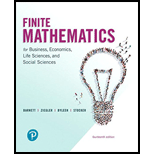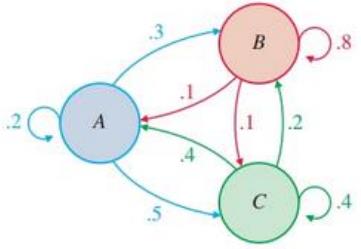
In Problems 27-32, use the transition diagram

to find
Want to see the full answer?
Check out a sample textbook solution
Chapter 9 Solutions
Finite Mathematics for Business, Economics, Life Sciences and Social Sciences
Additional Math Textbook Solutions
Fundamentals of Differential Equations and Boundary Value Problems
A Problem Solving Approach to Mathematics for Elementary School Teachers (12th Edition)
Calculus for Business, Economics, Life Sciences, and Social Sciences (14th Edition)
Finite Mathematics & Its Applications (12th Edition)
Thinking Mathematically (7th Edition)
Probability and Statistics for Engineers and Scientists
- 2. Suppose that in Example 2.27, 400 units of food A, 500 units of B, and 600 units of C are placed in the test tube each day and the data on daily food consumption by the bacteria (in units per day) are as shown in Table 2.7. How many bacteria of each strain can coexist in the test tube and consume all of the food? Table 2.7 Bacteria Strain I Bacteria Strain II Bacteria Strain III Food A 1 2 0 Food B 2 1 3 Food C 1 1 1arrow_forwardstate 1[.1 .1 .8 1. Consider the transition matrix P= state 2.5 5 0 state 3.7 0 3 a. Identify what the entry in row one, column three (the .8) represents: b. Find p (use your calculator. no work required): c. Identify what the entry in row two, column one of represents.arrow_forward2.Initially we have 2 red marbles in Box 1 and 2 white marble in Box 2. At every time step, we take a marble from each box and swap. Let Xt be the number of red marbles in Box 1 at time t. There are 3 states: 0, 1, 2. Let P be the transition matrix for {X;}, what is (P)oo (probability from state 0 to state 0)?arrow_forward
- Number 20 in the image attachedarrow_forwardLet us have the experience of a mouse falling into a trap inside a 6-room building, as shown in the figure below. If the room contains k doors, the probability that the mouse will choose one of these doors is 1/k if the mouse reaches room F that contains the food or room S that contains the trap. It will stay there and the experiment ends, the transition matrix is M= [0.5 0 0.5 0 0.3 0 0 ¹0.5 0 0 0.3 0.3 0 0.3 0.3 0 0.5 0 000 O a O b О с 2 000 0.5 0 0.5 0 0 0 0 0.3 0 0.5 0 0.5 M = - 0 0.5 0.5 b 3 ..+. 4 5 0 0 S M= 0 0 0 1 0 0.5 0 0 0 0 0.5 0 0 0.3 0.3 0 0 0.3 0 0.5 0 0 0.5 0 0 1 00000 10 0 000 0.5 0 0 0.5 0 0.3 0 0.3 0.3 0 0.3 0.3 0 0 0 0.5 0 0 000 0 0 0 0 C 0 0 0.3 0.5 1 (a)arrow_forwardConsider a communication channel where each substation transmits and receive data. The probability between the substations is shown in figure 3. 0.4 0.5 0.3 0.2 2 2 0.3 Figure 3 i. Draw a transition diagram. ii. Write down a transition matrix, P. iii. Name the type of matrix in Q3(b) P(X, =2 X, = 1|X, =3) iv. P(X, =2 X, = 3X, =2) V. enarrow_forward
- 5. consider the example below, where the states are Condition State and the transition matrix is 0 1 23 2 Πο Good as new Operable-minimum deterioration Operable-major deterioration Inoperable and replaced by a good-as-new machine we found that the steady-state probabilities are 2 13' T1= = P = 78314 00 1 0 7 13' HARTNO LELBLINO 1 16 1 1 1 1 16 8 8 0 2 2 = π2 2 13' I3 = 2 13 (a) Find the expected recurrence time for state 0 (i.e., the expected length of time a machine can be used before it must be replaced) by solving a linear system for Moo, M10, 20, and μ30. (b) Find the expected recurrence time for state O directly by the formula Moo 1 πο =arrow_forwardFor a transition matrix for a problem about people migrating from one region to another, O the columns will sum to 1 if there are no new people added to the system. if the number of people increase both rows and columns must sum to more than 1. O either the rows always sum to 1 or the columns always sum to 1 but not both. the rows will sum to 1 when the populations increase linearly. Question 5 ( , Find the answer that selects all the true statements about trace. a) If A = then tr(A) = 16. %3D b) If A and conform for multiplication in either order, then tr(AB) = tr(BA). c) If C conforms with A for multiplication CA, and A and B have the same dimensions, then tr(C(A + B)) = tr(C)tr(A) + tr(B)tr(C). d) If A and B conform for multiplication AB and C have the same dimensions as AB then tr(AB + C = tr(A)tr(B) + tr(C). Both c) and d).arrow_forward3. A study has determined that the occupation of a boy, as an adult, depends upon the occupation of his father and is given by the following transition matrix where P= professional, F= farmer and L= laborer Father's Occupation P F L 0.80 0.30 0.20 0.10 0.50 0.20 0.10 0.20 0.60 P Son's F Occupationarrow_forward
- Milan.sttarrow_forward3. A rat is put into the following maze: 3 moves. 1 2 The rat has a probability of 1/4 of starting in any compartment and suppose that the rat chooses a passageway at random when it makes a move from one compartment to another at each time. Let Xn be the compartment occupied by the rat after n (a) Explain why {X₂} is a MC and find the transition matrix P. (b) Explain why the chain is irreducible, aperiodic and positive recurrent. (c) What is the limit of Pn? Explain. (d) Find the probability that the rat is in compartment 3 after two moves. (e) In the long run, how many times that the rat enters in compartment 4 in 100 movements?arrow_forwardConsider a communication channel where each substation transmits and receive data. The probability between the substations is shown in figure 3. 0.4 0.5 0.3 0.2 2 2 3 0.3 Figure 3 i. Draw a transition diagram. ii. Write down a transition matrix, P. iii. Name the type of matrix in Q3(b) P(X; =2 X,=1\X, =3) iv. P(X; =2 _X,=3{X, =2) V.arrow_forward
 Linear Algebra: A Modern IntroductionAlgebraISBN:9781285463247Author:David PoolePublisher:Cengage Learning
Linear Algebra: A Modern IntroductionAlgebraISBN:9781285463247Author:David PoolePublisher:Cengage Learning
